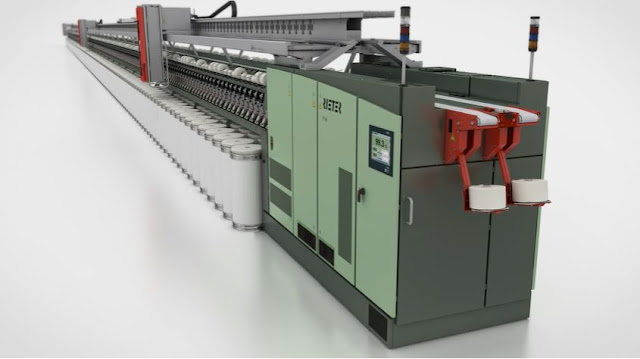The rotor spinning machine is a revolutionary innovation in the textile industry that has transformed the process of yarn production. This advanced machine combines efficiency, speed, and versatility to produce high-quality yarns in a cost-effective manner. In this article, we will explore the rotor spinning machine, its definition, objectives, functions, working process, and significance in the textile manufacturing process.
Definition Of Rotor Spinning Machine:
The rotor spinning machine is a specialized textile machine that converts fibers into yarn by spinning them through the use of a rapidly rotating rotor. It is a highly productive and flexible machine that can process various types of fibers, including cotton, polyester, viscose, and their blends. The rotor spinning machine has become a preferred choice for producing medium to coarse yarn counts due to its efficiency and ability to handle a wide range of fiber materials.
Objectives of the Rotor Spinning Machine:
The primary objectives of the rotor spinning machine are as follows:
1. Yarn Production: The main objective of the rotor spinning machine is to convert fibers into yarn. It aims to produce high-quality yarns with desirable characteristics such as strength, evenness, and uniformity.
2. Increased Productivity: The rotor spinning machine is designed for high-speed operation, enabling increased productivity compared to traditional spinning methods. It allows for faster yarn production, which is crucial in meeting the demands of a competitive textile market.
Functions of the Rotor Spinning Machine:
The rotor spinning machine performs several essential functions, including:
1. Fiber Opening and Cleaning: The machine opens and cleans the fiber mass, removing impurities, dust, and short fibers. This initial process ensures that the fibers fed into the machine are of good quality.
2. Fiber Feeding: The fibers are fed into the rotor spinning machine, where they are drawn into the spinning rotor.
3. Twisting and Yarn Formation: As the rotor spins rapidly, the fibers are twisted together to form a continuous yarn. The twisting action imparts strength and cohesion to the yarn.
4. Yarn Winding: The formed yarn is wound onto bobbins or cones, ready for further processing or use in textile manufacturing.
Working Process of the Rotor Spinning Machine:
The working process of the rotor spinning machine involves the following steps:
1. Fiber Preparation: The fiber mass undergoes opening and cleaning processes to remove impurities and ensure a consistent fiber supply.
2. Fiber Feeding: The prepared fibers are fed into the machine, which consists of a spinning rotor with multiple grooves or recesses.
3. Rotor Spinning: The spinning rotor rotates at high speed, generating centrifugal force that causes the fibers to be drawn into the rotor's recesses. The fibers are held in the recesses by frictional forces.
4. Twisting and Yarn Formation: As the rotor spins, the fibers are twisted together, forming a continuous yarn. The yarn is wound onto the surface of the rotor.
5. Yarn Removal: The wound yarn is continuously removed from the rotor's surface and wound onto bobbins or cones.
Significance of the Rotor Spinning Machine:
The rotor spinning machine has revolutionized yarn production in several ways:
1. High Productivity: The rotor spinning machine's high-speed operation enables faster yarn production, leading to increased productivity and shorter production cycles.
2. Cost Efficiency: The machine's ability to process a wide range of fiber materials, combined with its high productivity, results in cost-effective yarn production. It allows textile manufacturers to optimize their production processes and reduce operational costs.
3. Versatility: The rotor spinning machine can process different fiber materials and produce a variety of yarn types, making it highly versatile for diverse textile applications.
4. Quality Yarn Production: The rotor spinning machine produces yarn with excellent evenness, strength, and uniformity. It offers better control over yarn quality compared to traditional spinning methods, leading to enhanced product performance and customer satisfaction.
5. Sustainable Manufacturing: The rotor spinning machine's high efficiency and reduced energy consumption contribute to sustainable textile manufacturing practices, aligning with the industry's growing focus on environmental responsibility.
Conclusion:
The rotor spinning machine has revolutionized the textile industry by streamlining the yarn production process. Its high productivity, cost efficiency, versatility, and ability to produce high-quality yarns have made it a valuable asset for textile manufacturers. The rotor spinning machine's significance lies in its ability to meet the demands of a competitive market, optimize production processes, and deliver superior yarns for various textile applications. As technology continues to advance, the rotor spinning machine is expected to play an increasingly critical role in the future of textile manufacturing.














0 Comments